New Tesla Supercharger refills battery at 1,000 miles per hour - but only for the Model 3
Tesla has revealed a new third-generation Supercharger, which it claims can add range to the batteries of its cars at a rate of over 1,000 miles per hour.
This is more than double the rate of its second-generation chargers and, the company says, means up to 75 miles of driving range can be added in just five minutes. On average, charging time should be halved for many drivers.
Read More:
- What is Electrify America? How VW's diesel scandal spawned a $2bn US-wide EV charging network
- 7 things we learnt at the 2019 Geneva Motor Show
- Tesla Model Y: Everything we know so far
The new chargers can deliver power at a rate of 250kW, more than double the 120kW rate the company's existing chargers are limited to. However, Tesla added that it will soon up the power output of its second-generation chargers from 120kW to 145kW.
This is a significant improvement over the existing charging rate, but falls short of the 350kW offered by the Electrify America and Ionity charging networks, which will work with cars built by the Volkswagen Group, BMW, Daimler and others as the networks come online over the following months.
Tesla also says the new liquid-cooled chargers do not suffer from power splitting, where two cars parked at adjacent second-generation chargers would receive power at a slower rate, as they draw energy from the grid in pairs.
However, the new chargers can only deliver the headline 250kW rate to the Model 3, Tesla's newest car. Owners of the more expensive but older Model S and Model X (even if they are brand new vehicles) cannot enjoy the faster charging rate.
Addressing this, Tesla says those cars will receive a software update in the coming months to help boost their charging speed. But due to hardware differences, it is unlikely that software alone will help them match the Model 3's charge rate.
Tesla ia also rolling out a new feature where its cars automatically warm their battery when the driver approaches a Supercharger, bringing the battery up to the temperature at which it charges most efficiently. The company says this feature will cut charge times - even at older Superchargers - by an average of 25 percent.
Overall, the company believes the average Model 3 driver using a third-generation Supercharger will spend 15 minutes on each visit to the charger.
The first V3 Supercharger, in Fremont, California, is working right now, but it is only accessible for members of Tesla's 'early access program'. Once more V3 chargers are installed through April, Tesla will make them available to everyone.
Tesla said in a blog post: "V3 is a completely new architecture for Supercharging. A new 1MW power cabinet...supports peak rates of up to 250kW per car. At this rate, a Model 3 Long Range operating at peak efficiency can recover up to 75 miles of charge in five minutes and charge at a rate of up to 1,000 miles per hour...V3 Supercharging will ultimately cut the amount of time customers spend charging by an average of 50 percent, as modelled on our fleet data"
